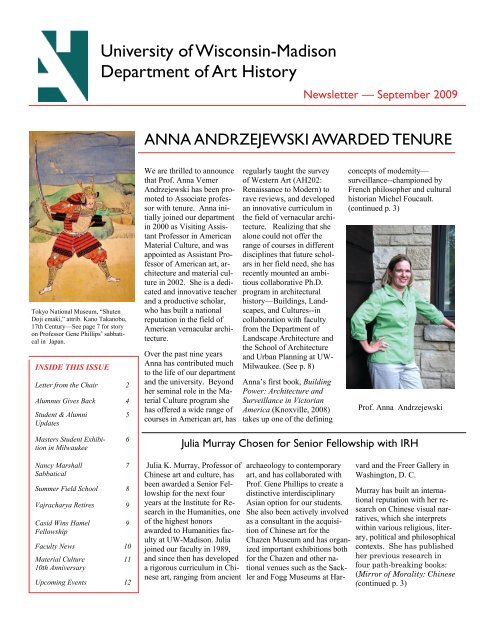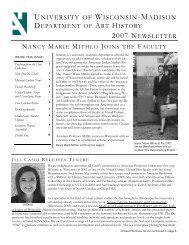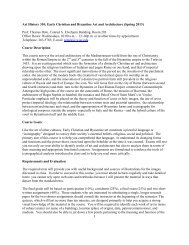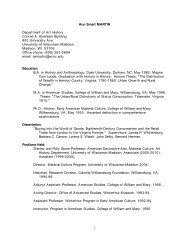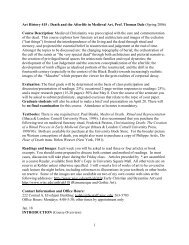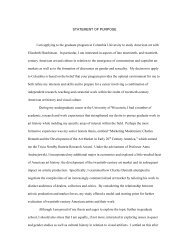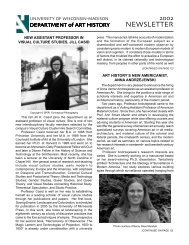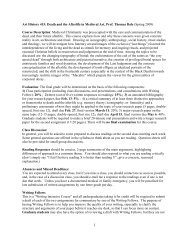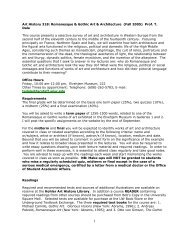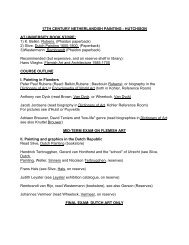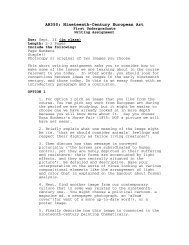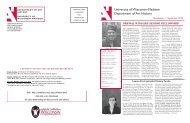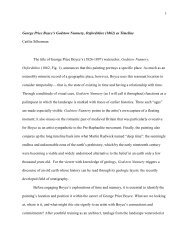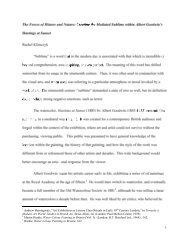newsletter 2009.pub - Art History - University of Wisconsin-Madison
newsletter 2009.pub - Art History - University of Wisconsin-Madison
newsletter 2009.pub - Art History - University of Wisconsin-Madison
You also want an ePaper? Increase the reach of your titles
YUMPU automatically turns print PDFs into web optimized ePapers that Google loves.
Tokyo National Museum, “Shuten<br />
Doji emaki,” attrib. Kano Takanobu,<br />
17th Century—See page 7 for story<br />
on Pr<strong>of</strong>essor Gene Phillips’ sabbatical<br />
in Japan.<br />
INSIDE THIS ISSUE<br />
Letter from the Chair 2<br />
Alumnus Gives Back 4<br />
Student & Alumni<br />
Updates<br />
Masters Student Exhibition<br />
in Milwaukee<br />
Nancy Marshall<br />
Sabbatical<br />
Summer Field School 8<br />
Vajracharya Retires 9<br />
Casid Wins Hamel<br />
Fellowship<br />
Faculty News 10<br />
Material Culture<br />
10th Anniversary<br />
6<br />
7<br />
11<br />
Upcoming Events 12<br />
<strong>University</strong> <strong>of</strong> <strong>Wisconsin</strong>-<strong>Madison</strong><br />
Department <strong>of</strong> <strong>Art</strong> <strong>History</strong><br />
5<br />
9<br />
We are thrilled to announce<br />
that Pr<strong>of</strong>. Anna Vemer<br />
Andrzejewski has been promoted<br />
to Associate pr<strong>of</strong>essor<br />
with tenure. Anna initially<br />
joined our department<br />
in 2000 as Visiting Assistant<br />
Pr<strong>of</strong>essor in American<br />
Material Culture, and was<br />
appointed as Assistant Pr<strong>of</strong>essor<br />
<strong>of</strong> American art, architecture<br />
and material culture<br />
in 2002. She is a dedicated<br />
and innovative teacher<br />
and a productive scholar,<br />
who has built a national<br />
reputation in the field <strong>of</strong><br />
American vernacular architecture.<br />
Over the past nine years<br />
Anna has contributed much<br />
to the life <strong>of</strong> our department<br />
and the university. Beyond<br />
her seminal role in the Material<br />
Culture program she<br />
has <strong>of</strong>fered a wide range <strong>of</strong><br />
courses in American art, has<br />
regularly taught the survey<br />
<strong>of</strong> Western <strong>Art</strong> (AH202:<br />
Renaissance to Modern) to<br />
rave reviews, and developed<br />
an innovative curriculum in<br />
the field <strong>of</strong> vernacular architecture.<br />
Realizing that she<br />
alone could not <strong>of</strong>fer the<br />
range <strong>of</strong> courses in different<br />
disciplines that future scholars<br />
in her field need, she has<br />
recently mounted an ambitious<br />
collaborative Ph.D.<br />
program in architectural<br />
history—Buildings, Landscapes,<br />
and Cultures--in<br />
collaboration with faculty<br />
from the Department <strong>of</strong><br />
Landscape Architecture and<br />
the School <strong>of</strong> Architecture<br />
and Urban Planning at UW-<br />
Milwaukee. (See p. 8)<br />
Anna’s first book, Building<br />
Power: Architecture and<br />
Surveillance in Victorian<br />
America (Knoxville, 2008)<br />
takes up one <strong>of</strong> the defining<br />
Newsletter — September 2009<br />
ANNA ANDRZEJEWSKI AWARDED TENURE<br />
concepts <strong>of</strong> modernity—<br />
surveillance--championed by<br />
French philosopher and cultural<br />
historian Michel Foucault.<br />
(continued p. 3)<br />
Julia Murray Chosen for Senior Fellowship with IRH<br />
Julia K. Murray, Pr<strong>of</strong>essor <strong>of</strong><br />
Chinese art and culture, has<br />
been awarded a Senior Fellowship<br />
for the next four<br />
years at the Institute for Research<br />
in the Humanities, one<br />
<strong>of</strong> the highest honors<br />
awarded to Humanities faculty<br />
at UW-<strong>Madison</strong>. Julia<br />
joined our faculty in 1989,<br />
and since then has developed<br />
a rigorous curriculum in Chinese<br />
art, ranging from ancient<br />
archaeology to contemporary<br />
art, and has collaborated with<br />
Pr<strong>of</strong>. Gene Phillips to create a<br />
distinctive interdisciplinary<br />
Asian option for our students.<br />
She also been actively involved<br />
as a consultant in the acquisition<br />
<strong>of</strong> Chinese art for the<br />
Chazen Museum and has organized<br />
important exhibitions both<br />
for the Chazen and other national<br />
venues such as the Sackler<br />
and Fogg Museums at Har-<br />
Pr<strong>of</strong>. Anna Andrzejewski<br />
vard and the Freer Gallery in<br />
Washington, D. C.<br />
Murray has built an international<br />
reputation with her research<br />
on Chinese visual narratives,<br />
which she interprets<br />
within various religious, literary,<br />
political and philosophical<br />
contexts. She has published<br />
her previous research in<br />
four path-breaking books:<br />
(Mirror <strong>of</strong> Morality: Chinese<br />
(continued p. 3)
PAGE 2<br />
Letter from the chair—Thomas E. A. Dale<br />
Our department has much to celebrate<br />
in terms <strong>of</strong> the achievements <strong>of</strong> faculty<br />
and students, and new opportunities<br />
for intellectual growth. A new<br />
faculty member in the field <strong>of</strong> modern<br />
American art, Lauren Kroiz (story in<br />
next issue) will join us in fall 2010,<br />
and we have attracted the largest number<br />
<strong>of</strong> applicants to our graduate program<br />
in many years. We look forward<br />
to new possibilities to collaborate with<br />
the Chazen Museum as work begins<br />
on a new wing to open in Fall 2011.<br />
I have four priorities as Chair: rethinking<br />
our undergraduate curriculum;<br />
hiring new faculty to enhance our<br />
global cultural reach; expanding our<br />
development efforts; and fostering a<br />
greater sense <strong>of</strong> intellectual community.<br />
Curriculum: We began to reshape<br />
our undergraduate curriculum by instituting<br />
an undergraduate methods<br />
course to better prepare our majors for<br />
graduate work and teaching careers.<br />
We are exploring alternatives to our<br />
traditional surveys that reflect the diverse<br />
approaches and cultures now<br />
included in our department. For example,<br />
we are considering a team-taught<br />
global arts survey.<br />
Expanding our Global Reach: As<br />
we seek to broaden our curriculum,<br />
our top priority is to hire a specialist in<br />
Islamic art—an area increasingly vital<br />
for all our students. We also hope to<br />
add positions in contemporary Asian,<br />
Latin American or Caribbean art, and<br />
in Indian and South Asian <strong>Art</strong>.<br />
Development: We are grateful to all<br />
our alumni and friends who support<br />
our department in various ways and<br />
we are looking for ways <strong>of</strong> better<br />
engaging you—we welcome your<br />
input. We also seek better support<br />
for our talented graduate students.<br />
We have one success story to report.<br />
In collaboration with the Chazen Museum,<br />
we have inaugurated a Curatorial<br />
Internship for one <strong>of</strong> our students<br />
to work on museum projects.<br />
Ph.D. candidate Matthew Rarey will<br />
help create an installation <strong>of</strong> African<br />
and Diaspora art from the permanent<br />
collection for the Chazen’s new<br />
wing. We seek donors to support<br />
similar opportunities for our students<br />
in the future (our share <strong>of</strong> the curatorial<br />
internship costs just over<br />
$10,000.00 for the year). We hope to<br />
fund other students with a project to<br />
digitize Emeritus Pr<strong>of</strong>. Frank Horlbeck’s<br />
incomparable archive <strong>of</strong> slides<br />
<strong>of</strong> medieval art and architecture,<br />
which he has generously donated to<br />
our department.<br />
Department Theme: As faculty<br />
and students are drawn increasingly<br />
to interdisciplinary groups across<br />
campus, many <strong>of</strong> us feel the need to<br />
bring the department together for<br />
intellectual exchange. For some<br />
years now, a regular colloquium has<br />
shared the research <strong>of</strong> faculty and<br />
graduate students once a month. This<br />
fall we are trying something more<br />
ambitious—a department-wide theme<br />
that will be the focus <strong>of</strong> much <strong>of</strong> our<br />
public programming as well as indi-<br />
Matthew Rarey Awarded Chazen Curatorial Internship<br />
vidual courses over the next two years,<br />
coinciding with the campus-wide Year<br />
<strong>of</strong> the Humanities and the Year <strong>of</strong> the<br />
<strong>Art</strong>s. Our theme “Object, Body, Mind<br />
and the Senses” recognizes the fundamental<br />
roles that objects, works <strong>of</strong> art,<br />
architecture and visual culture in various<br />
media play across all cultures and time<br />
periods in mediating human experience,<br />
connecting the physical and the immaterial<br />
worlds, the body and the senses with<br />
the spiritual. In the fall, students will<br />
have an opportunity to take two courses<br />
related to the theme: a special topics<br />
course team-taught by Pr<strong>of</strong>s. Casid and<br />
Martin, and Pr<strong>of</strong>. Drewal’s seminar on<br />
African Masking and the Senses. In<br />
collaboration with Material Culture and<br />
the Visual Culture Center, we are <strong>of</strong>fering<br />
an ambitious series <strong>of</strong> public lectures<br />
and symposia. The fall program will<br />
include lectures by John Onians from the<br />
Courtauld Institute <strong>of</strong> <strong>Art</strong> in London and<br />
Michael Taussig <strong>of</strong> Columbia <strong>University</strong><br />
in New York, as well as symposia on<br />
Race and New Media, <strong>Art</strong>s, Sciences and<br />
the Senses, and Surveillance. Spring<br />
topics include Worlding Perception—<br />
Objects and Materiality, and Objects, the<br />
Senses and Religious Experience in the<br />
West from late Antiquity to the Early<br />
Modern Period.<br />
We have an exciting year ahead and we<br />
invite you to participate in all <strong>of</strong> our<br />
public events (please visit our website,<br />
www.arthistory.wisc.edu, for listings).<br />
We welcome your continued support as<br />
members <strong>of</strong> Friends <strong>of</strong> <strong>Art</strong> <strong>History</strong>, and<br />
would be happy to hear your news and<br />
input.<br />
Ph.D. candidate Matthew Francis Rarey has been awarded the Chazen Museum’s Graduate<br />
Curatorial Internship for the 2009-2010 academic year, a new initiative that <strong>of</strong>fers our<br />
graduate students valuable museum experience. The position is jointly funded by the<br />
Chazen and <strong>Art</strong> <strong>History</strong>. Rarey will be working with Chazen Director Russell Panczenko<br />
and Pr<strong>of</strong>. Henry Drewal to plan, curate, and execute a new installation <strong>of</strong> the Chazen’s collection<br />
<strong>of</strong> African art for the museum’s new wing opening in 2011. Matthew comes to the<br />
Chazen with extensive museum experience: as Registration Assistant at the Spurlock Museum<br />
<strong>of</strong> World Cultures at the <strong>University</strong> <strong>of</strong> Illinois at Urbana-Champaign (2002-04), as<br />
Regenstein Intern in South Pacific Anthropology at the Field Museum <strong>of</strong> Natural <strong>History</strong> in<br />
Chicago (summer 2005), and as a collections assistant in the Field Museum’s Department <strong>of</strong><br />
Anthropology (2005-06).
Julia Murray Senior Fellow...<br />
Narrative Illustration<br />
and Confucian Ideology<br />
(2007); Ma Hezhi<br />
and the Illustration <strong>of</strong><br />
the Book <strong>of</strong> Odes<br />
(1993); Last <strong>of</strong> the<br />
Mandarins (1987);<br />
and A Decade <strong>of</strong> Discovery<br />
(1979).<br />
During her tenure<br />
as Senior Fellow,<br />
Julia will complete<br />
her book, “Mysteries<br />
<strong>of</strong> Kongzhai: Relic,<br />
Representation, and<br />
ritual at a Shrine <strong>of</strong><br />
Confucius.” This ambitious<br />
project <strong>of</strong>fers<br />
the first, comprehen-<br />
sive study <strong>of</strong> the<br />
art and material<br />
culture associated<br />
with the<br />
<strong>of</strong>ficial cult <strong>of</strong><br />
China’s most<br />
celebrated public<br />
figure, Confucius,<br />
focused at the<br />
shrine <strong>of</strong><br />
Kongzhai (near<br />
Shanghai), established<br />
as early as<br />
the 7th century<br />
CE. Pr<strong>of</strong> Murray<br />
will explore the<br />
significant shifts<br />
Bust Portrait <strong>of</strong> Confucius as Minister<br />
<strong>of</strong> Justice in the State <strong>of</strong> Lu, rubbing <strong>of</strong><br />
in cult practices<br />
incised stone tablet, dated 1734, Beilin and the recep-<br />
collection, Xi'an, China<br />
Jordi Falgas, <strong>Art</strong> <strong>History</strong> Ph.D. candidate, Presents New Book<br />
Anna Andrzejewski Awarded Tenure...<br />
Instead <strong>of</strong> merely “applying” Foucault<br />
as so many other scholars have done,<br />
she defines alternative modalities <strong>of</strong><br />
surveillance, both positive and negative,<br />
performed in a series <strong>of</strong> distinct<br />
settings ranging from domestic interiors<br />
to religious campgrounds. Carla<br />
Yanni <strong>of</strong> Rutgers <strong>University</strong> praises<br />
Building Power as “a major contribution<br />
to the history <strong>of</strong> architecture, vernacular<br />
theory and the study <strong>of</strong> surveillance.”<br />
As for future plans, Andrzejewski is<br />
already at work on a sequel, Surveillance<br />
in Twentieth-Century American<br />
Culture. A second project, in collaboration<br />
with historian James Jacobs <strong>of</strong><br />
the National Parks Service, will fo-.<br />
PAGE 3<br />
tion <strong>of</strong> Confucius from the time <strong>of</strong> the<br />
shrine’s inception up to its recent revival,<br />
set against the backdrop <strong>of</strong> social,<br />
political, religious, economic and<br />
cultural conditions in China. She has<br />
published two articles related to this<br />
research: "'Idols' in the Temple: Icons<br />
and the Cult <strong>of</strong> Confucius", Journal <strong>of</strong><br />
Asian Studies. 68 no. 2 (2009);<br />
and "The Global Rebranding <strong>of</strong> Confucius"<br />
in China in 2008: A Year <strong>of</strong> Great<br />
Significance, edited by Jeffrey Wasserstrom,<br />
Kate Merkel-Hess, and Kenneth<br />
Pomeranz. (Lanham, Md.: Rowman &<br />
Littlefield, 2009). She is also working<br />
on an exhibition focusing on Confucius<br />
for the China Institute Gallery in New<br />
York, opening February 11, 2010.<br />
Ph.D. Candidate Jordi Falgas’s new book reached the bookstores on April 23rd and was presented at a press conference in<br />
Barcelona on May 5th. Jordi has edited “El Palau de la Música Catalana” (Barcelona: Triangle), a 240 pages picture-book<br />
devoted to the architecture <strong>of</strong> this concert hall designed by Lluís Domènech i Montaner in Barcelona, completed in 1908.<br />
The book has a preface by Robert Hughes and photographs by Ricard Pla and Pere Vivas. Jordi has written chapter introductions<br />
and short texts to accompany the 200 photographs and artworks included in the book, a chronology, and biographies <strong>of</strong><br />
the many craftsmen who worked in the building's construction. The book has been published simultaneously in two editions,<br />
one in Catalan/Spanish/English and another in French/Italian/German.<br />
Carla Yanni <strong>of</strong> Rutgers <strong>University</strong> praises<br />
Building Power as “a major contribution to<br />
the history <strong>of</strong> architecture, vernacular<br />
theory and the study <strong>of</strong> surveillance.”<br />
cus on architecture, planning and<br />
sociology <strong>of</strong> American postwar suburbia.<br />
Living up to the ideals <strong>of</strong> the <strong>Wisconsin</strong><br />
Idea, she is also developing,<br />
with Pr<strong>of</strong>. Arnold Alanen (UW Landscape<br />
Architecture) a book surveying<br />
the varied traditions <strong>of</strong> vernacular<br />
architecture within the rural landscape<br />
<strong>of</strong> southwestern <strong>Wisconsin</strong>, a<br />
project that will directly involve her<br />
own students. Further raising UW-<br />
<strong>Madison</strong>’s pr<strong>of</strong>ile in the field,<br />
Andrzejewski is lead organizer for<br />
the Vernacular Architecture Forum’s<br />
national conference to be held in<br />
<strong>Madison</strong> in 2012. We rejoice in having<br />
such an accomplished scholar and<br />
teacher in our midst!
PAGE 4<br />
I have been curator <strong>of</strong> modern art at the<br />
Pennsylvania Academy <strong>of</strong> the Fine <strong>Art</strong>s<br />
in Philadelphia for almost five years.<br />
During this time, I’ve been involved in<br />
every aspect <strong>of</strong> the institution. Working<br />
at a mid-sized museum has given<br />
me the opportunity to explore a broad<br />
range <strong>of</strong> artists and themes from the<br />
nineteenth-century to the present.<br />
Among the most recent exhibitions I<br />
have organized for PAFA are: Harnett,<br />
Peto, and their Accomplices: Trompe<br />
l'oeil Paintings from the Collection<br />
(2008), Jacob Lawrence's Hiroshima<br />
(2008), George Tooker: A Retrospective<br />
(2009), and Elizabeth Osborne:<br />
The Color <strong>of</strong> Light (2009).<br />
For recent George Tooker and Peter<br />
Saul retrospectives, we planned an ambitious<br />
series <strong>of</strong> programs geared towards<br />
scholars and students, artists<br />
Reflections on Curatorial Work by Bob Cozzolino, Ph.D. (2006)<br />
interested in hands-on workshops, high<br />
school kids interested in graphic novels<br />
and comics, and grammar school kids<br />
learning about how artists engage with<br />
history. The Saul symposium, "On the<br />
Limits and Possibilities <strong>of</strong> Politics in<br />
<strong>Art</strong>" (Nov, 1, 2008) aimed at putting<br />
the challenging and confrontational<br />
work <strong>of</strong> Peter Saul (born 1934) in its<br />
political and historical context. Rather<br />
than invite scholars, I asked artists to<br />
come together and discuss the role and<br />
importance <strong>of</strong> politics in their work.<br />
The program, coupled with the Saul<br />
exhibition helped demonstrate PAFA's<br />
seriousness as a venue for contemporary<br />
art and revealed the tangible connections<br />
between Saul's <strong>of</strong>ten savage<br />
critiques <strong>of</strong> contemporary events and<br />
political art <strong>of</strong> the past. It also showed<br />
his place in the current cultural climate.<br />
Jon Sorenson, Alumnus, on Giving Back to <strong>Art</strong> <strong>History</strong><br />
A two-day symposium on Tooker in<br />
March 2009 expanded on the new research<br />
and writing presented in our<br />
exhibition catalogue. For this I invited<br />
eight scholars who in most cases had<br />
never written about Tooker before to<br />
speak on various topics ranging from<br />
Piero della Francesca's influence on<br />
Tooker to issues <strong>of</strong> race and homelessness<br />
in the artist’s work.<br />
My position at PAFA has required a<br />
strong foundation in the broader history<br />
<strong>of</strong> art. In particular my duel studies at<br />
the UW-<strong>Madison</strong> in Medieval art and<br />
Modernism found practical application<br />
in the research I did on Tooker. This<br />
grounding continues to guide my efforts<br />
as a curator.<br />
Contact the UW Foundation regarding your gift for<br />
the <strong>Art</strong> <strong>History</strong> Department: E-mail:<br />
uwf@uwfoundation.wisc.edu<br />
Phone: 608-263-4545<br />
Fax: 608-263-0781<br />
As an <strong>Art</strong> <strong>History</strong> major at UW-<strong>Madison</strong>, I experienced first-hand the wonderful world <strong>of</strong> dark lecture halls filled with images<br />
brought to life by pr<strong>of</strong>essors. I was captivated with the stories that surrounded each work <strong>of</strong> art being discussed and<br />
terrified by the amount <strong>of</strong> detail that had to be remembered for the exam. My career has taken many twists and turns, but I<br />
am thankful that the love <strong>of</strong> art and the critical thinking skills that I learned while pursuing my <strong>Art</strong> <strong>History</strong> degree at the UW<br />
have been a constant.<br />
I am now in a position to give back to the department that gave me so much. I am a donor and am honored to be able to<br />
work on behalf <strong>of</strong> the Department <strong>of</strong> <strong>Art</strong> <strong>History</strong> as their Director <strong>of</strong> Development at the <strong>University</strong> <strong>of</strong> <strong>Wisconsin</strong> Foundation.<br />
I have the pleasure <strong>of</strong> working with alumni from both the department and <strong>University</strong> who look back at their <strong>Art</strong> <strong>History</strong><br />
experience as one <strong>of</strong> the best on campus. Many <strong>of</strong> us have gone on to careers outside <strong>of</strong> the <strong>Art</strong> <strong>History</strong> field, but recognize<br />
the importance <strong>of</strong> using the skills we learned, keeping our passion for art alive, and nurturing creativity in ourselves and others.<br />
Gifts for scholarships, travel, curatorial internships, and graduate support help maintain the excellence <strong>of</strong> the department and<br />
enrich the experience <strong>of</strong> students. Whether it is a permanently endowed fund or annual contribution, every gift <strong>of</strong> any<br />
amount is appreciated and put to productive and immediate use. In addition to cash gifts, deferred gifts such as bequests,<br />
trusts, and life income agreements are an excellent way to shape the future <strong>of</strong> the department.<br />
Thank you for your support and please consider me as a resource for information on how you can contribute to the excellence<br />
<strong>of</strong> the <strong>Art</strong> <strong>History</strong> department. On <strong>Wisconsin</strong>!<br />
Jon E. Sorenson, BA, ‘85<br />
Director <strong>of</strong> Development College <strong>of</strong> Letters & Science<br />
Jon.sorenson@uwfoundation.wisc.edu or 608-262-7211
Ph.D.:<br />
Soo Yeon Park (12/08): “Use <strong>of</strong> Devotional<br />
Images in the Seventeenth-Century Northern<br />
Netherlands: A Case Study <strong>of</strong> Prints by Abraham<br />
Bloemaert (1566-1651)” Hutchison, Phillips,<br />
Dale, Casid, Jolanda Taylor (German)<br />
Elizabeth Hooper-Lane (5/09): “Domestic<br />
Modernism in Middle America: Midwestern<br />
Women in their Postwar Homes” Martin,<br />
Andrzejewski, Virginia Boyd (Env. Textiles,<br />
Design), Jean Lee (<strong>History</strong>), Buenger<br />
Nichole N. Bridges (8/09): “Contact, Commentary,<br />
and Kongo Memory: Perspectives on<br />
Loango Coast Souvenir Ivories, ca. 1840-<br />
1910” Drewal, Marshall, Casid, Florence<br />
Bernault (<strong>History</strong>), Aliko Songolo (Afr. Lang.<br />
& Lit.)<br />
Saadia Nicoe Lawton (8/09): “Contested<br />
Meanings: Audience Responses to the Wedgewood<br />
Slave Medallion, 1787-1839” Andrzejewski,<br />
Martin, Dale, Geiger, Beverly Gordon<br />
(Env. Textiles, Design)<br />
MA:<br />
Katharine Wells (5/09): Marshall, Casid<br />
Lucy Traverse (8/09): Casid, Marshall<br />
Graduating Seniors, May 2009:<br />
Francesca Batista, Aaron Belson, Elizabeth<br />
Bogart, Laura Brandstetter, Kathryne Brietlow,<br />
Andrea Bromley, Louisa Brouwer, Kelly<br />
Brown, Katharine Campbell, Jessica Clark,<br />
Daphne Evans, Daniel Fuchs, Leah Gahr, Evgenia<br />
Goryshina, Emily Green, Mia Gruenberg,<br />
Dana Harkness, Sarah Hersh-Boyle,<br />
Emily Jefko, Seunghye Kim, Rebecca<br />
Koehler, Kate Kudish, Dinah Langsjoen, Kristin<br />
Marx, Katherine McBrair, Monica<br />
McCann, Aurelia Moser, Kimberly Mueller,<br />
Alison Muller, Meaghan Olwell, Ellen Pennow,<br />
Audrey Ryou, Miriam Samuels-<br />
Schwartz, Molly Schneiderman, Kate Skarda,<br />
Stephanie Sokolowski, Andrew Talen, Greta<br />
Van Lith, Alexis Vogel, Jennifer Zolper<br />
Alumni:<br />
Tom Atwood (MA ’95) received a Graduate Business<br />
Certificate in Corporate Finance from Daniels<br />
College <strong>of</strong> Business, <strong>University</strong> <strong>of</strong> Denver, 2008.<br />
Jane Bianco (MA ’04) is a Curatorial Assistant at<br />
Farnsworth <strong>Art</strong> Museum, Friendship, Maine, and is<br />
currently curating a show on Homer, Whistler,<br />
Marin and Bellows.<br />
Nichole Bridges (Ph.D. ‘09) is the Associate Curator<br />
for African <strong>Art</strong> and Dept. Head for the <strong>Art</strong>s <strong>of</strong><br />
Africa, the Americas, Asia, and the Pacific Islands at<br />
the Baltimore Museum <strong>of</strong> <strong>Art</strong> in Baltimore, MD.<br />
Louisa Brouwer (BA 2009) began , in July, a twoyear<br />
fellowship with U <strong>of</strong> Delaware and Winterthur<br />
Museum as an MA candidate in Winterthur Program-American<br />
Material Culture.<br />
Student and Alumni Updates<br />
Nancy Demerdash (BA ’06) is currently completing<br />
an MS in Architecture Studies in the Aga<br />
Khan Program for Islamic Architecture at MIT.<br />
In the fall <strong>of</strong> ’09 she will begin her Ph.D. at<br />
Princeton <strong>University</strong> studying architecture in<br />
West Africa as it relates to colonialism.<br />
Antje Gamble (BA ’05) completed her MA at<br />
the <strong>Art</strong> Institute <strong>of</strong> Chicago, ’09, and was teaching<br />
at Columbia College, Chicago. She will continue<br />
at U-Mich for her Ph.D. in Italian 20 th<br />
Century <strong>Art</strong>.<br />
Ryan Grover (MA ’03) is curator at the Biggs<br />
Museum <strong>of</strong> American <strong>Art</strong>, Wilmington, DE. He<br />
wears multiple hats as Project Coordinator, Contributor,<br />
Curator and Fund Raiser.<br />
Noelle Giuffrida (MA ’99)[Ph.D. Univ. <strong>of</strong> Kansas]<br />
will be starting a tenure-track position teaching<br />
Chinese art at Case Western Reserve <strong>University</strong><br />
in Cleveland, Ohio. She was previously a<br />
Visiting Assistant Pr<strong>of</strong>essor at Vassar College<br />
and has recently gotten married.<br />
Erin Hagness (BA ’06) curator <strong>of</strong> Collections,<br />
Evanston <strong>History</strong> Center, Evanston, IL, is currently<br />
overseeing inventory and conservation <strong>of</strong><br />
collection.<br />
Ray Hernández-Durán (MA ’94)<br />
is an Assistant Pr<strong>of</strong>essor at the Univ. <strong>of</strong> New<br />
Mexico. Primary area <strong>of</strong> expertise: Early Modern<br />
Ibero-American <strong>Art</strong>s and Architecture (New<br />
Spain, Peru, Caribbean, Philippines).<br />
Aaron Joseph (BA ’00) received an MBA from<br />
Univ. <strong>of</strong> Chicago ’08. He continues to be passionate<br />
about art and is looking for ways to contribute<br />
to museums, galleries, and education.<br />
Marina Kliger (MA ’08) is Communications<br />
Assistant, Interpretive Exhibitions and<br />
Family Programs, Dept.<strong>of</strong> Museum Education,<br />
<strong>Art</strong> Institute Of Chicago.<br />
Jarryd Page (BA 08) is working on his MA<br />
at Kansas <strong>University</strong>.<br />
Jae-Suk Park (Ph.D. ’07, postdoctoral<br />
fellow 2008-09) presented a paper at the<br />
Fifth International Daoist Studies Conference:<br />
The Past, Present, and Future <strong>of</strong> Daoism,<br />
in June 2009, at Wudangshan, Hubei,<br />
China.<br />
Greg Seiffert (MA ’06)[now a Ph.D. student<br />
at Princeton] is one <strong>of</strong> the co-authors <strong>of</strong><br />
the recent exhibition catalogue “Outside In:<br />
Chinese x American x Contemporary<br />
<strong>Art</strong>/” (Princeton: Princeton <strong>University</strong> <strong>Art</strong><br />
Museum, 2009). He has recently passed his<br />
qualifying exams and become a dissertator,<br />
working on artists in Nanjing in the seventeenth<br />
century.<br />
Junhyoung Michael Shin (Ph.D. ’01) is<br />
currently Associate Pr<strong>of</strong>essor in the <strong>Art</strong><br />
<strong>History</strong> Department at Myongji <strong>University</strong>,<br />
Seoul, Korea.<br />
Lauren Sthal (BA ’07) is a graduate student<br />
in Landscape Architecture at UC-<br />
Berkeley.<br />
Becky Straus (BA ’02) is Asst. Director <strong>of</strong><br />
Individual Giving, Orpheus Chamber Orchestra,<br />
New York, NY.<br />
PAGE 5<br />
Spring and Summer 2009 Ph.D Graduates and Faculty Advisors: (L to R)<br />
Elizabeth Hooper-Lane, Pr<strong>of</strong>. Ann Smart Martin, Saadia Lawton, Pr<strong>of</strong>. Gail Geiger, Nichole<br />
Bridges and Pr<strong>of</strong>. Henry Drewal
PAGE 6<br />
Masters Student, BA Harrington’s work<br />
exhibited at Milwaukee <strong>Art</strong> Museum<br />
Lineal Conversion, 2009 Red oak, linen, silk organza,<br />
embroidery floss 36" x 45" x 19 1/2" , a part<br />
<strong>of</strong> installation, “Lineage”<br />
BA Harrington, currently completing her Masters in<br />
our department, is one <strong>of</strong> our many talented students<br />
who has come to art history from the realm <strong>of</strong> artmaking.<br />
After completing an MFA in 2007 under the<br />
supervision <strong>of</strong> Tom Loeser, distinguished studio furniture<br />
artist teaching in UW’s <strong>Art</strong> Department, BA<br />
joined us to pursue an M.A. in Material culture, drawn<br />
by that program’s emphasis on integrating materiality,<br />
artistic practice and cultural history. She remains an<br />
active artist and was recently honored by inclusion in<br />
an exhibition at the Milwaukee <strong>Art</strong> Museum, Remains:<br />
Contemporary <strong>Art</strong>ists and the Material Past<br />
(February 12 – June 7, 2009), curated by Ethan<br />
Lasser, Chipstone curator and adjunct assistant pr<strong>of</strong>essor<br />
in our department.<br />
The exhibition featured pieces by Harrington, by Beth<br />
Lipman and Sarah Lindley, each <strong>of</strong> whom contributed<br />
a body <strong>of</strong> work that reinterprets material objects from<br />
the past. Harrington’s own installation, Lineage was<br />
inspired by an early-American dowry chest in the<br />
Chipstone Collection. Its title refers both to the lineage<br />
<strong>of</strong> her own woodworking skills traced back to her<br />
grandfather, and the anonymous female ancestry represented<br />
by the traditional dowry chests and needlework<br />
alluded to in BA’s work. On another level, the<br />
piece and its title focus on the transformation <strong>of</strong> physical<br />
line. Lineage also reveals an exciting synergy that<br />
results from wedding artistic imagination and traditional<br />
craft with an art historical critical consciousness.<br />
As Harrington explained in an interview with fellow<br />
art history classmate Katherine Wells, her work comprises<br />
three interconnected disciplines. “There’s my<br />
traditional training as a furniture maker, then my art<br />
training in the MFA program, and then the scholarly<br />
research <strong>of</strong> the art history program. I do see all three<br />
<strong>of</strong> these as part <strong>of</strong> the same practice; they all feed into<br />
each other. When I build things my skills are intuitive,<br />
they’re second nature to me because I know my<br />
tools and materials like the back <strong>of</strong> my hand. When I<br />
Two <strong>Art</strong> <strong>History</strong> Majors gain valuable museum<br />
experience at the Ringling<br />
By an interesting coincidence, two <strong>of</strong> our talented art history<br />
undergraduate majors, Andrew Scott and Cassie Olien, both<br />
served as interns at the John and Mable Ringling Museum <strong>of</strong><br />
<strong>Art</strong> in Sarasota, Florida this past summer. They <strong>of</strong>fer a<br />
glimpse into the kinds <strong>of</strong> seminal experiences that help prepare<br />
our students for future careers as museum pr<strong>of</strong>essionals<br />
and pr<strong>of</strong>essors.<br />
Andrew is a senior double-majoring in <strong>History</strong> and <strong>Art</strong> <strong>History</strong>.<br />
With the help <strong>of</strong> Head Librarian Linda McKee, he<br />
worked on provenance research for selected objects in the<br />
collection. One <strong>of</strong> the works Andrew focused on was Giampietrino’s<br />
Death <strong>of</strong> Lucretia, which may be based on Giampietrino's<br />
Lucretia in the Chazen Museum <strong>of</strong> <strong>Art</strong>. His research<br />
at the Ringling was facilitated by access to many useful<br />
resources, including the museum’s Rare Books Collection, its<br />
library registrar files, Ringling's personal art history library,<br />
and the objects themselves. Andrew also attended a series <strong>of</strong><br />
staff-led seminars on management, conservation, curatorial<br />
and exhibition work, estate planning, and registrar duties,<br />
which have <strong>of</strong>fered important insights into the inner workings<br />
<strong>of</strong> museums. In addition, he gave private tours <strong>of</strong> the <strong>Art</strong><br />
Museum, the Circus Museum, and the Cà d' Zan. Finally, he<br />
has had the privilege to sit in on director's meetings, as well as<br />
multiple “webinars.” As Andrew writes, “it has been an experience<br />
I will not soon forget, and I strongly recommend it to<br />
any student.”<br />
Cassie Olien, a senior art history major and honors student<br />
with an additional certificate in Integrated Liberal Studies<br />
(ILS), recently received the Ruth Knatz Memorial Fund Prize,<br />
a scholarship awarded by the ILS department. She was also<br />
hired by the Ringling to do research on their collection. Like<br />
Andrew, she attended staff-led seminars on various topics and<br />
took advantage <strong>of</strong> private tours <strong>of</strong> the local museums and the<br />
Ringling’s historic home, the Cà d' Zan. She was particularly<br />
excited by the "business <strong>of</strong> museums" crash course led by the<br />
director. According to Cassie, “these seminars and tours have<br />
given me great insight as to what goes into different museum<br />
jobs. The experience has been absolutely wonderful … and I<br />
have even come across a great idea for the senior honors thesis<br />
I plan to complete this upcoming year.”<br />
was trained as a furniture maker we were taught how to make<br />
reproductions and it was all about solid construction and fine<br />
craftsmanship. And now through my art training both the conceptual<br />
and physical building processes have become completely<br />
integrated… (W)hat I want to do with the art history degree is the<br />
same kind <strong>of</strong> thing. I know the historical context <strong>of</strong> these archetypal<br />
early-American furniture forms that I’m taking on, and I<br />
want my scholarly research to become integrated with my work<br />
at an intuitive level….To me that is the most exciting thing about<br />
Lineage…”
Gene Phillips Investigates Demons and Monsters in Japanese <strong>Art</strong><br />
Gene Phillips recently returned from<br />
sabbatical in Japan, where he was affiliated<br />
with Gakushûin <strong>University</strong>,<br />
Tokyo. He spent the year conducting<br />
research on “Shuten Dôji,” a story <strong>of</strong><br />
slaying demons and rescuing abducted<br />
women, believed to have emerged with<br />
illustrations in the fourteenth century.<br />
From the late 16th through the early<br />
19th century, the tale enjoyed enormous<br />
popularity and was given visual<br />
form in illustrated handscrolls and<br />
books, screen paintings, woodblock<br />
prints, and plays. A year <strong>of</strong> research in<br />
Japan has allowed Gene to produce the<br />
first full translation <strong>of</strong> the text <strong>of</strong> the<br />
second oldest and by far most influen-<br />
Nancy Rose Marshall explores<br />
Pre-Raphaelite painter<br />
Dante Gabriel Rossetti<br />
Pr<strong>of</strong>. Nancy Rose Marshall spent her sabbatical researching a<br />
monograph on the Victorian painter and poet Dante Gabriel<br />
Rossetti (1828-1882). One <strong>of</strong> the three leading members <strong>of</strong><br />
the Pre-Raphaelite Brotherhood, Rossetti helped shift attitudes<br />
to painting toward the modernist notion that form,<br />
color, and harmonious composition were more important<br />
aesthetic attributes than moralizing or elevating subjects.<br />
With their daring meditations on the inseparability <strong>of</strong> the<br />
body from the soul, Rossetti’s painting and poetry contemplated<br />
the same searching questions posed by the most innovative<br />
scientists <strong>of</strong> the period. The deliberate dissolution <strong>of</strong><br />
persistent categories <strong>of</strong> Western thought in the artist’s work<br />
blurred conceptual and representational boundaries, <strong>of</strong>ten also<br />
encouraging a confusion <strong>of</strong> self and image in the way the<br />
viewer related to it. Commissioned by Phaidon Press, Marshall’s<br />
book covers Rossetti's entire career with a focus on the<br />
shifting understanding <strong>of</strong> mind-body connections in the science,<br />
literature, medicine, and visual representation <strong>of</strong> the period.<br />
Working in Britain in the fall, Marshall undertook archival<br />
research, viewed paintings and drawings in British collections,<br />
and surveyed the extensive historical and secondary literature<br />
on the Pre-Raphaelites. In the Spring she returned to <strong>Madison</strong><br />
as fellow at the UW-<strong>Madison</strong>’s Institute for Research in the<br />
Humanities. Besides giving papers at the North American Victorian<br />
Studies Association in New Haven, CT and a symposium<br />
on the art <strong>of</strong> John William Waterhouse at the Royal Academy,<br />
London, she published an article,<br />
tial version <strong>of</strong> the story; view and photograph<br />
various illustrated versions;<br />
and read the abundant recent Japanese<br />
scholarship on Shuten Dôji and related<br />
topics. Most importantly, he had time<br />
to develop new insights for understanding<br />
the history and nature <strong>of</strong> its<br />
illustrations. He is able to point to<br />
close connections between pictorial<br />
content and elements <strong>of</strong> purification,<br />
protection, and healing rituals practiced<br />
in Japan from ancient times<br />
down to the present. In pursuing this<br />
topic, he attended a number <strong>of</strong> protection<br />
rites at temples and shrines, the<br />
most dramatic being one at the temple<br />
Engyôji in Himeji.<br />
In June, he gave a presentation in<br />
Japanese at Gakushûin on his findings,<br />
and is translating and adapting<br />
it for upcoming talks at the Freer<br />
Gallery <strong>of</strong> <strong>Art</strong> in Washington and<br />
Harvard’s Reischauer Institute. His<br />
work on ritual will immediately have<br />
a dramatic impact on his teaching as<br />
he reconfigures his course on art and<br />
religious practice in medieval Japan<br />
for the fall. He also plans to <strong>of</strong>fer a<br />
seminar on art and monstrosity in the<br />
spring, using his Shuten Dôji research<br />
as a catalyst and inspiration<br />
for students and his own research<br />
projects.<br />
Nancy and Dante Gabriel Rossetti, Sibylla Palmifera 1870<br />
(Liverpool: Walker <strong>Art</strong> Gallery)<br />
‘James Tissot’s Coloured Photographs <strong>of</strong> Vulgar Society’ in<br />
Victorian Vulgarity, edited by Susan Bernstein and Elsie<br />
Michie (Ashgate 2009), and made final revisions to her book<br />
manuscript “City <strong>of</strong> Gold and Mud: Representing Victorian<br />
London” (Paul Mellon Centre/Yale <strong>University</strong> Press, 2010).<br />
Next Spring, Marshall will integrate her new research into a<br />
400-level course based partly on her sabbatical research,<br />
“Vision and Desire: Pre-Raphaelitism.” Her own digital<br />
photographs <strong>of</strong> the work <strong>of</strong> Rossetti and other Pre-<br />
Raphaelites and transcriptions <strong>of</strong> archival documents will<br />
<strong>of</strong>fer her students unique resources.<br />
PAGE 7
PAGE 8<br />
Students gain hands-on experience in Summer Field-school for new<br />
Buildings-Landscapes-Cultures Program<br />
Pr<strong>of</strong>. Andrzejewski (left) instructs Caitlin Boyle (center), UW-Mil. Ph.D.<br />
student and Jaclyn Binder Wakefield (right), UW-<strong>Madison</strong> M.A. student, on<br />
drawing an elevation <strong>of</strong> Wiota's general store.<br />
This summer, Pr<strong>of</strong>. Anna Andrzejewski co-taught with Janet Gilmore<br />
the first summer fieldschool class as part <strong>of</strong> the Buildings-<br />
Landscapes-Cultures Companion Program. This innovative, joint<br />
Ph.D. program between UW-<strong>Madison</strong> and UW-Milwaukee,<br />
founded by Pr<strong>of</strong>. Andrzejewski in collaboration with Pr<strong>of</strong>. Arijit<br />
Sen (UW-Milwaukee, School <strong>of</strong> Architecture), has garnered local,<br />
national and international attention for allowing for faculty and student<br />
collaboration and interaction across two academic institutions.<br />
Required <strong>of</strong> all students after their first year <strong>of</strong> Ph.D. coursework,<br />
the month-long fieldschool is a core part <strong>of</strong> the BLC curriculum<br />
because it focuses on teaching students hands-on methods. This<br />
year, the fieldschool took place in Wiota, <strong>Wisconsin</strong>, a small village<br />
in Lafayette County. Wiota has a sizable, previously undocumented,<br />
concentration <strong>of</strong> vernacular houses dating to the 1830s<br />
associated with settlement by William S. Hamilton and others who<br />
came to the region to mine lead ore. In 95-degree heat over the<br />
course <strong>of</strong> a week, the twelve students gained valuable practical<br />
experience, learning to record buildings through measured draw-<br />
ings, conduct interviews with local residents knowledgeable about the region’s history, and perform archival research. Back in<br />
<strong>Madison</strong>, students turned fieldnotes into final drawings and composed formal reports on their research. The data they collected on<br />
Wiota will form part <strong>of</strong> a conference <strong>of</strong> the Vernacular Architecture Forum (VAF) that Pr<strong>of</strong>. Andrzejewski is organizing in <strong>Wisconsin</strong><br />
in 2012. The students’ final drawings will appear in the conference guidebook alongside narratives the students wrote on<br />
the buildings.<br />
Thanks to generous support from the Chipstone foundation, Thomas Carter (<strong>University</strong> <strong>of</strong> Utah, School <strong>of</strong> Architecture), a pioneer<br />
in the field <strong>of</strong> American vernacular Architecture, joined the class during their week in the field to teach architectural documentation.<br />
Pr<strong>of</strong>. Carter said he had never seen such a dedicated group <strong>of</strong> students produce such high quality drawings without<br />
any previous experience. He believes the success <strong>of</strong> the inaugural fieldschool bodes well for the future <strong>of</strong> the BLC program. For<br />
more on the program see http://arthistory.wisc.edu/architecturaloption/index.html and our future website at www.blc.wisc.edu.<br />
Martin’s Sabbatical in England enriches teaching/research on American Decorative <strong>Art</strong>s<br />
Pr<strong>of</strong>. Ann Smart Martin spent Spring 2008 in England, doing research, studying museum collections, speaking at conferences,<br />
and participating in other scholarly gatherings. As guest researcher at the Victoria and Albert Museum in London, she explored<br />
decorative arts and furniture in that institution’s permanent collections, and studied how the V & A and Royal College <strong>of</strong> <strong>Art</strong><br />
graduate program collaborate on teaching museum studies and involving students in exhibitions as potential models for our own<br />
collaboration with the Chazen Museum. She was also consultant for the <strong>University</strong> <strong>of</strong> Warwick’s new material culture program,<br />
strengthening ties that have already brought British students to study with her in <strong>Madison</strong>.<br />
Pr<strong>of</strong>. Martin’s research focused on her current book project, “Banish the Night: Illumination and Reflection in England and<br />
America, 1650-1850” which analyzes how light was manipulated, augmented, and ultimately transformed in Britain and America<br />
in the early modern period. She visited historic houses to examine the English antecedents for American homes and the extravagant<br />
choices made by wealthy noble and mercantile families. She also studied English timber frame houses as models for the<br />
dwellings <strong>of</strong> the colonial elites whose taste, fashion and household styles were shaped by examples from abroad. Travel in<br />
Europe allowed Martin to explore comparisons from eighteenth-century households in Spain, Germany, Holland and Ireland.<br />
Visiting the Palace Het Loo in the Netherlands, for example, she examined the most important site for changes in late senteenthcentury<br />
decorative arts style in England and America.<br />
Ann’s experience in England has already enriched her teaching in concrete ways. In the fall, she taught a new seminar on illumination<br />
and reillumination and reflection, The <strong>Art</strong> <strong>of</strong> Light (AH565). She also improved older courses. With funding from DoIT<br />
she produced short podcast interviews with curators who discuss museum practice and teaching with objects; these will be shown<br />
in her undergraduate course, <strong>History</strong> <strong>of</strong> Decorative <strong>Art</strong>s and Interiors: 1607-1840 (AH 363). In one example, two curators look at<br />
objects in storage at the Victoria and Albert Museum in London, debating visual evidence and possible techniques that help understand<br />
and classify individual objects—a wonderful demonstration <strong>of</strong> curatorial practice. Other material from museums and<br />
exhibitions in Europe will be incorporated into Martin’s Introduction to Museums (AH 601-602).
Gautama Vajracharya Awarded<br />
Lecturer Emeritus Status<br />
Emeritus Pr<strong>of</strong>essor Gautama Vajracharya Receiving Gift From <strong>Art</strong><br />
<strong>History</strong> Department<br />
Gautama Vajracharya, lecturer in Indian art, has been awarded the title<br />
<strong>of</strong> lecturer Emeritus. A specialist in Sanskrit language and literature<br />
and in Buddhist iconography, Gautama has regularly taught our students<br />
Indian art history and Buddhist iconography since 1990, making<br />
a significant contribution to our Asian option. Gaining a strong following<br />
among our undergraduates, he was nominated for the prestigious<br />
Chancellor’s Hilldale Award for Excellence in Teaching in 2000.<br />
Two former students, who have gone on to become successful scholars<br />
in the field, Dr. Saleema Waraich, Smith College, and Dr. Katherine<br />
Anne Paul, Curator <strong>of</strong> Asian <strong>Art</strong> at the Newark Museum, both spoke,<br />
together with Dr. Pratyapaditya Pal, at a symposium held in his honor<br />
last September.<br />
Dr. Vajracharya has garnered an international reputation in his interpretation<br />
<strong>of</strong> inscriptions and religious iconography. He has also played<br />
a significant role as curator, assisting Pratyapaditya Pal in cataloging<br />
the South Asian collection at the Los Angeles County Museum, and<br />
contributing to the catalogue <strong>of</strong> the acclaimed exhibition, Himalayas:<br />
An Aesthetic Adventure shown at the <strong>Art</strong> Institute <strong>of</strong> Chicago in 2003.<br />
For the UW’s Chazen Museum, he has regularly served as consultant<br />
for acquisitions <strong>of</strong> South Asian art, and he wrote the definitive catalogue<br />
<strong>of</strong> the museum’s Watson Collection <strong>of</strong> Indian miniatures. Gautama<br />
and his wife will continue to live in <strong>Madison</strong> but will also be<br />
spending more time on the West coast with their son and his family.<br />
We wish them both a very happy retirement.<br />
Learn more about the Visual Culture<br />
Program by visiting its web page:<br />
http://www.visualculture.wisc.edu/<br />
Jill Casid Wins Hamel Fellowship<br />
PAGE 9<br />
Pr<strong>of</strong>. Jill Casid has been awarded a Hamel Faculty Fellowship<br />
in the College <strong>of</strong> Letters and Sciences, a prestigious<br />
award that will support her research over the<br />
next five years. Casid is one <strong>of</strong> a handful <strong>of</strong> scholars<br />
actively shaping the new trans-disciplinary field <strong>of</strong><br />
Visual Culture Studies. She asks such basic questions<br />
as “How do we see and perceive, and is seeing physiological<br />
or cultural?” She also explores how representational<br />
processes affect our perception <strong>of</strong>, or serve to<br />
control people <strong>of</strong> other races, genders and sexual orientations.<br />
Since joining our department in 2002, Casid has<br />
played a central role in building the campus-wide Visual<br />
Culture cluster <strong>of</strong> faculty and developing a new<br />
interdisciplinary program which has attracted a strong<br />
following among undergraduates and graduate students<br />
alike. She is founding director <strong>of</strong> the Visual Culture<br />
Center (2007), under whose auspices she has organized<br />
many engaging symposia and workshops, involving<br />
film theorists, neuroscientists, biologists, art historians,<br />
historians and artists in the search for answers to larger<br />
questions.<br />
Pr<strong>of</strong>. Casid is author <strong>of</strong> two books, Sowing Empire:<br />
Landscape and Colonization (<strong>University</strong> <strong>of</strong> Minnesota<br />
Press, 2005) and Shadows <strong>of</strong> Enlightenment: Reason,<br />
Magic, and Technologies <strong>of</strong> Projection (<strong>University</strong> <strong>of</strong><br />
Minnesota Press, to be published later this year). During<br />
her fellowship, she will work on three new book<br />
projects. The Volatile Image: Other Histories <strong>of</strong> Photography<br />
explores non-Western traditions <strong>of</strong> early photography<br />
in Latin America and India, and considers<br />
practices <strong>of</strong> photography relating to sexual and gender<br />
subcultures. She is also editing two anthologies:<br />
Transcultural Genealogies: Post-colonial Theory and<br />
the Story <strong>of</strong> Modern <strong>Art</strong> and Visual Transculture.<br />
Pr<strong>of</strong>essor Jill Casid
PAGE 10<br />
Faculty News<br />
In December 2008 Suzy Buenger travelled<br />
to the St. Louis <strong>Art</strong> Museum to<br />
consult on the cataloguing <strong>of</strong> their collection<br />
<strong>of</strong> the German expressionist<br />
Max Beckmann. She has published an<br />
article on Beckmann’s portraits from<br />
the Weimar era (in Of Truths Impossible<br />
to Put In Words: Max Beckmann<br />
Contextualized (Munich, 2009)), and<br />
lectured on “German Prints from War<br />
to Weimar: Methods and Meanings,”<br />
for the exhibition “Impassioned Images:<br />
German Expressionist Prints” at<br />
Vassar College. She also won a European<br />
Studies Program Grant to develop<br />
a new course on the fate <strong>of</strong> art in World<br />
War II, The Rape <strong>of</strong> Europa, for which<br />
she conducted research in Italy this<br />
summer.<br />
As Director <strong>of</strong> the Sardis excavations in<br />
Turkey, Nick Cahill has supervised<br />
work at four sites: the Acropolis, which<br />
has produced two more <strong>of</strong> the earliest<br />
coins ever made; the ancient theater,<br />
where they are uncovering a Lydian<br />
house destroyed in the sixth century<br />
BC; a terrace near the theater<br />
to investigate the city plan; and the<br />
early Lydian fortification. Cahill is also<br />
planning an exhibition <strong>of</strong> Lydian art<br />
and archaeology for the Yapı Kredi<br />
Bank's Vedat Nedim Tör Museum in<br />
Istanbul, opening on Jan. 19, 2010. He<br />
has edited and contributed an essay to<br />
the volume, Love for Lydia: A Sardis<br />
Anniversary Volume Presented to<br />
Crawford H. Greenewalt, Jr. (Harvard<br />
<strong>University</strong> Press, 2008), and has spoken<br />
on his recent Sardis research at<br />
Harvard and Berkeley, and in conference<br />
papers in Ankara, Turkey, and in<br />
San Francisco.<br />
Thomas Dale pursued research on Romanesque<br />
sculpture in France in March<br />
with a grant from the Center for European<br />
Studies. His article on the nude in<br />
Romanesque sculpture is in press (New<br />
Approaches to Romanesque Sculpture,<br />
Brepols, 2009), as are two other studies<br />
related to his new book project on cultural<br />
appropriation and hybridity in<br />
medieval Venice, one for Dumbarton<br />
Oaks Studies, the other for The Byzantine<br />
World (Routledge, 2009). In the<br />
spring, he gave lectures on the Romanesque<br />
sculpture and multi-sensory religious<br />
experience at the Center for Me-<br />
dieval Studies in Poitiers, France and at<br />
Columbia <strong>University</strong> in New York. In<br />
July he lectured in Ravenna, Italy on the<br />
“Mosaics <strong>of</strong> Ravenna through the eyes<br />
<strong>of</strong> Dante” for the NEH Summer Seminar<br />
for College Pr<strong>of</strong>essors on Dante, directed<br />
by UW-<strong>Madison</strong>’s Chris Kleinhenz.<br />
Henry Drewal opened his Mami Wata<br />
exhibition in March at the National Museum<br />
<strong>of</strong> African <strong>Art</strong>-Smithsonian in<br />
Washington, DC which received a rave<br />
review by Holland Cotter <strong>of</strong> the New<br />
York Times on Friday, April, 3, 2009.<br />
Drewal also wrote the catalogue for the<br />
international traveling exhibition,<br />
“Dynasty and Divinity: Ife <strong>Art</strong> in Ancient<br />
Nigeria” opening at the Fundación<br />
A 13th century copper alloy casting from<br />
Ife -- one <strong>of</strong> 109 works on display in Spain<br />
Marcelino Botin in Santander, Spain in<br />
June. He has edited two exhibition catalogues,<br />
Sacred Waters: <strong>Art</strong>s for Mami<br />
Wata and other Water Divinities in Africa<br />
and the Diaspora (Indiana <strong>University</strong><br />
Press, 2008), and Mami Wata: <strong>Art</strong>s<br />
for Water Spirits in Africa and Its Diasporas<br />
(<strong>University</strong> <strong>of</strong> Washington Press/<br />
Fowler Museum, 2008). Awarded a<br />
Senior Fellowship at the Sainsbury Research<br />
Unit, <strong>University</strong> <strong>of</strong> East Anglia,<br />
UK for the spring 2010, he will work on<br />
his new book, "Senses in Understanding<br />
<strong>of</strong> <strong>Art</strong>: <strong>Art</strong>s <strong>of</strong> the Yoruba-speaking People<br />
in West Africa."<br />
Dan Fuller’s <strong>Wisconsin</strong> Bioscope film<br />
company will have two films shown in<br />
August at the Jornada Brasileira de Cinema<br />
Silencioso, an annual silent film<br />
festival sponsored by the Brazilian<br />
national film archive in Sao Paolo.<br />
In October, two other short films will<br />
be part <strong>of</strong> the Giornate del Cinema<br />
Muto, the world’s largest silent film<br />
festival, held in Pordenone, Italy. In<br />
September he begins a new appointment<br />
as special librarian for the <strong>Wisconsin</strong><br />
Center for Theater and Film<br />
Research, where he will be working<br />
primarily with the archive’s collection<br />
<strong>of</strong> still photographs. (See<br />
www.wisconsinbioscope.com).<br />
Gail Geiger has been devoting much<br />
<strong>of</strong> her time to the <strong>University</strong> Committee<br />
which meets on a weekly basis<br />
throughout the year to advise the UW<br />
Chancellor. She also was one <strong>of</strong> three<br />
external reviewers invited to evaluate<br />
the American <strong>University</strong> <strong>of</strong> Rome’s<br />
Department <strong>of</strong> <strong>Art</strong> <strong>History</strong>.<br />
Jane Hutchison gave an invited lecture<br />
on “High and Low Music in<br />
Netherlandish Painting” at a memorial<br />
symposium honoring the late<br />
Charles Cuttler held at Loyola <strong>University</strong><br />
Museum in Chicago.<br />
Narciso Menocal published an article<br />
related to his ongoing book project<br />
on Cuban nationalism in art and<br />
culture in the volume Cuba: Contrapuntos<br />
de cultura, historia y sociedad<br />
/ Counterpoints on Culture,<br />
<strong>History</strong> and Society. (Ediciones<br />
Callejón, 2007).<br />
Among many honors and awards last<br />
year, Nancy Mithlo won a Ford<br />
Foundation Grant; a research award<br />
from the Graduate School for the<br />
Horace Poolaw photography archive,<br />
a UW Research Service Award, and a<br />
Visual and Expressive <strong>Art</strong>s Award<br />
from the Smithsonian Museum <strong>of</strong> the<br />
American Indian to support her exhibition<br />
“Rendezvoused” at the Venice<br />
Biennale. She has also been awarded<br />
a two-year Vilas Associate Award<br />
and a Woodrow Wilson Career Enhancement<br />
Award to support her research<br />
leave next year, which she<br />
will devote to preparing her book on<br />
the exhibition <strong>of</strong> indigenous American<br />
artists at Venice Biennale from<br />
1999-2009. Her first book, ’Our<br />
Indian Princess’: Subverting the<br />
Stereotype. (Santa Fe, NM. 2009) has<br />
just appeared.
Material Culture Celebrates 10th Anniversary Under Martin’s Leadership<br />
This past year we celebrated the tenth anniversary <strong>of</strong> Pr<strong>of</strong>. Ann Smart<br />
Martin’s appointment as first Stanley and Polly Stone Pr<strong>of</strong>essor <strong>of</strong> Decorative<br />
<strong>Art</strong>s and Material Culture with the support <strong>of</strong> the Chipstone Foundation<br />
<strong>of</strong> Milwaukee. Since arriving on campus in 1998, Pr<strong>of</strong>. Martin has<br />
overseen the establishment <strong>of</strong> an innovative multi-disciplinary program in<br />
material culture, fostering collaboration among faculty and students from<br />
art history, design, history, folklore studies, landscape architecture and<br />
anthropology. Serving as Material Culture’s founding director, Martin has<br />
enriched the department’s curriculum by introducing a team-taught survey,<br />
Dimensions <strong>of</strong> Material Culture, and a broad range <strong>of</strong> specialized<br />
courses ranging in topic from American and British furniture and decorative<br />
arts in the eighteenth century to Outsider art in contemporary <strong>Wisconsin</strong>.<br />
Martin emphasizes engaging the students with objects directly, involving<br />
them regularly in special exhibition courses that draw upon <strong>Wisconsin</strong><br />
collections—including the Chipstone Collection <strong>of</strong> Milwaukee, the<br />
Caxambus Foundation <strong>of</strong> Milwaukee, and UW’s Chazen Museum. Students<br />
have learned the complex processes <strong>of</strong> conceptualizing and physically<br />
mounting exhibitions destined to be viewed by a broader public<br />
throughout the state. Another form <strong>of</strong> outreach has involved students<br />
Pr<strong>of</strong>essor Ann Smart Martin<br />
working as interns on collections and small exhibitions throughout the<br />
state, including the Kohler Foundation, the <strong>Wisconsin</strong> State Historical Society, the Chipstone Foundation and the Milwaukee<br />
<strong>Art</strong> Museum. Pr<strong>of</strong>s. Martin and Andrzejewski also regularly explore the material culture and vernacular architecture <strong>of</strong> the<br />
state through field trips and field-study courses, including Martin’s course on “Vernacular <strong>Art</strong>: <strong>Art</strong>s <strong>of</strong> the Edge” and<br />
Andrzejewski’s summer field-school in Wiota, <strong>Wisconsin</strong> (see page 8).<br />
Our department’s curriculum in material culture has been enriched by three visiting or adjunct pr<strong>of</strong>essors, supported by<br />
Chipstone: Anna Andrzejewski (2000-02), Glenn Adamson (2001-2006) and Ethan Lasser (2008 to the present). Martin has<br />
also overseen the development <strong>of</strong> essential supporting resources, including the Digital Library for the Decorative <strong>Art</strong>s, a<br />
collection <strong>of</strong> digital texts and images; the Material culture program website, which showcases virtual exhibitions produced<br />
by students and annual student objects studies from the Dimensions <strong>of</strong> Material Culture class; and the <strong>Wisconsin</strong> Decorative<br />
<strong>Art</strong>s Database, which <strong>of</strong>fers the public an online catalogue <strong>of</strong> decorative arts objects made in <strong>Wisconsin</strong> in the nineteenth<br />
and early twentieth centuries. Another recent initiative under the umbrella <strong>of</strong> Material Culture is the Buildings-Landscapes-<br />
Cultures (BLC) architectural history program, developed by Pr<strong>of</strong>. Andrzejewski in collaboration with faculty from UW-<br />
Milwaukee.<br />
The anniversary year was highlighted by public lectures given by Material Culture’s leading scholars, including Henry<br />
Glassie and Pravina Shukla, Dell Upton, Cary Carson and Ann Smart Martin herself. Dean Gary Sandefur hosted a celebratory<br />
dinner for Material Culture following Dr. Cary Carson’s lecture in March. Finally Pr<strong>of</strong>. Martin herself gained important<br />
recognition with three honors. Her book, Buying into the World <strong>of</strong> Goods: Early Consumers in Backcountry Virginia (Johns<br />
Hopkins <strong>University</strong> Press, 2008), was awarded the Fred Kniffen Book Award from the Association for the Preservation <strong>of</strong><br />
<strong>Art</strong>ifacts and Landscapes in October, and the Hagley Award, for the best book in business history in 2009 by the Business<br />
<strong>History</strong> Association. She was also elected member <strong>of</strong> the prestigious American Antiquarian Association.<br />
A clear measure <strong>of</strong> the program’s success is the growth <strong>of</strong> its faculty and the attraction <strong>of</strong> increasing numbers <strong>of</strong> students.<br />
Thirty-two undergraduates have enrolled in the Certificate program since its inception and a half dozen art history graduate<br />
students have gone through the program. Another sign <strong>of</strong> strength is the recent foundation <strong>of</strong> the Material Culture Forum, an<br />
interdisciplinary organization for students, faculty, and alumni (contact BA Harrington, bharrington@wisc.edu or Stefan<br />
Osdene, stefan_osdene@yahoo.com.).<br />
“The Material Culture Program at the <strong>University</strong> <strong>of</strong> <strong>Wisconsin</strong>-<strong>Madison</strong> examines forms, uses, and meanings<br />
<strong>of</strong> objects, images, and environments in everyday life. We want to take a fresh look at old categories <strong>of</strong> study<br />
in order to discover untold stories.”<br />
Read more about it at: http://www.materialculture.wisc.edu/index.htm<br />
PAGE 11
232 Elvehjem Building<br />
800 <strong>University</strong> Avenue<br />
<strong>Madison</strong>, WI 53706<br />
Phone: 608-263-2340<br />
Fax: 608-265-6425<br />
DEPARTMENT OF ART<br />
HISTORY<br />
UNIVERSITY OF<br />
WISCONSIN-MADISON<br />
UPCOMING EVENTS IN THE ART HISTORY DEPARTMENT<br />
Thursday & Friday, Sept. 24 & 25 : Grad Forum Presents: - Two Day Event!<br />
Lecture and workshop with Jacqueline Jung, Assistant Pr<strong>of</strong>essor, Medieval <strong>Art</strong> and Architecture, Yale <strong>University</strong><br />
Lecture topic: "The Tactile and the Visionary: Notes on the Place <strong>of</strong> Sculpture in the Medieval Religious Imagination"<br />
Thursday, October 8: Visual Culture Center and Eye Research Institute Presents:<br />
First Annual Eye Research Institute Vision Science & Visual <strong>Art</strong>s Poster and Gallery Session:<br />
Seeing: Beyond the <strong>Art</strong>/Science Divide<br />
Visit the Visual Culture web page for complete details <strong>of</strong> this event: http://www.visualculture.wisc.edu/<br />
Thursday, November 5th: <strong>Art</strong> <strong>History</strong> Department Presents:<br />
Friends <strong>of</strong> <strong>Art</strong> <strong>History</strong> Lecture with speaker Pr<strong>of</strong>. Nancy Marshall<br />
Thursday, November 12th: <strong>Art</strong> <strong>History</strong> Department Presents:<br />
Department Colloquium with speaker Pr<strong>of</strong>. Nancy Mithlo<br />
Visit: http://arthistory.wisc.edu/ahweek.html<br />
for up to date listings on these events and others!


